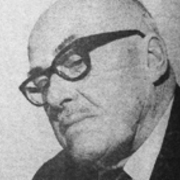
Bob Lapresle
Unusually for a new recruit, when he joined the National Film Unit in 1952, Robert Henry (‘Bob’) Lapresle already had years of experience behind him, having worked as a cinematographer and film director in Britain, Hollywood and his native Canada. As a production assistant requiring little in the way of training, he simply had to adjust to his new environment in New Zealand and within the Public Service.
From late 1952, the Pictorial Parade magazine-film series, issued monthly, was the NFU’s staple output, allowing production trainees to learn production techniques and practise on short items. Perhaps because of his experience, Lapresle worked on only a handful of items for Pictorial Parade, although two of his single-subject reels were released as part of this series – No Random Harvest (1954, released as Pictorial Parade No. 25) and Our Student Guests (1964, released as Pictorial Parade No. 153).
Many of the early films he made at the National Film Unit were departmental information films. Among the first he completed were How’s Your Smile (1953) and A Friendly Career (1953), both made for the Health Department, and Telephone Talk (1953) made for the Post and Telegraph Department. Like many films to follow, they were written, edited, and directed by him.
Such films, usually made to further some aspect of a department’s responsibilities, such as health education, or even to foster recruitment, were generally aimed at the non-theatrical market: 16mm copies were circulated through departmental film libraries or the National Film Library.
Most of Lapresle's films from 1960 onwards were made in colour and destined for theatrical release. They covered aspects of the scenery of his adopted country, notably in The Long Green Mantle (1964) and Alpine Airways, as well as its music and culture: in such films as National Youth Orchestra (1961), Ballet in New Zealand (1963), and Songs of the Maori (1964). One of the last films he made for the NFU was the lyrical Rotorua Symphony (1965) giving impressions of the thermal attractions without the usual narration, relying instead on a specially-composed musical score by Ashley Heenan, and harking back in style to the silent days in which his career had begun.
Having reached the prescribed age, he retired from the NFU in 1965. By this time television was providing a new outlet for locally-produced films, so retirement from the NFU did not mean retiring from film work. For Associated Film Makers Ltd, an affiliate of Peach Wemyss Ltd, he continued to produce films and television programmes; some, like half-hour series Landscape, were made partly to provide training for staff at the NZ Broadcasting Corporation.
In Landscape the focus was on people and personalities, rather than scenery, which was then being covered by the NZBC’s popular series Looking at New Zealand. Landscape would cover such varied topics as small-town Tūākau, a family shearing gang, muttonbirders exercising their customary rights, the dying days of steam locomotives, day-to-day life for a policeman, and Kiwi artists and sculptors. In all, 12 programmes were made — six in 1968, and six in 1969.
Laprele was also a consultant and producer on further productions including Te Rangitahi (1971) and several episodes for documentary slot Survey. He also worked with director Geoff Murphy on the groundbreaking Uenuku (1974) the first television drama filmed entirely in te reo Māori. Lapresle is listed as scriptwriter.
Bob Laprelse died on 11 October, 1987, aged 87.
Writing and original research by Clive Sowry; updated on 6 August 2021
Sources include
'Lapresle, Robert Henry (Bob)' (Death Notice) – The Dominion, 13 October 1987, page 27
‘TV producer at home’ – The Dominion, Golden Coast Project, 27 February 1970, page 7
‘Landscape: A new series’ – New Zealand Listener, 20 June 1969, page 10 (Volume 61, number 1549)
‘Natural Advantages of N.Z. Has Makings of Good Film Work’ – The Evening Post, 15 July 1965, page 14